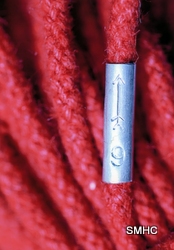
The Scottish Mountain Heritage Collection
Objects Database
Avalanche cord
Accession Number
1138.2014.1
Object Name
Avalanche cord
Created
08/07/2014
Creator
Hermione Cooper
Accession Date
08/07/2014
Brief Description
Length of red avalanche cord
Materials
Cotton
Dimensions
20m long
Number Of Objects
1
Colour
red
Provenance
Human beings have been getting buried in avalanches ever since they learned to stand upright and walk on snow covered terrain, and as a consequence they have been inventing methods of how to avoid them, and how to be rescued if buried in one ever since.
The advent of mountaineering and skiing as recreational sports in the 19th and 20th centuries introduced more and more people into snow covered terrain. Meanwhile, having had tens of thousands of their troops wiped out by avalanches over many centuries the great armies of the world started to think about some damage limitation.
The Austro - Hungarian Alpine Companies were one of the first to equip their troops with avalanche cords during the First World War and in the following decades other armies and recreational mountaineers followed suit.
Function
An avalanche cord is 20-25 metres long and about 3.5 mm thick. It is usually made of red cotton with directional arrows positioned at metre intervals, each with the length marked in metres, and 10cm long loops. It is wound into a ball. The ski mountaineer or climber ties the loop with the 1 metre mark (arrow against himself) around his waist. If there is a risk of avalanche he throws the ball out and pulls the avalanche cord along the snow behind him. If he is buried by an avalanche, there is a relatively good chance that part of the avalanche cord will be visible on top of the avalanche slide, thanks to its length. Rescuers can determine from the direction arrow, in which direction and how many metres they must dig and are able to follow the cord to the victim.
Technology in the form of avalanche transceivers (see related items) have pretty much rendered these cords obsolete though neither address the real issue which is to recognise avalanche danger in the first place and avoid it.
As indicated above, this cord would have originally been in a ball, but having used it a couple of times, we can't remember how to make the ball!
Acquisition Method
Donated by Art McCarthy
Acquisition Date
08/07/2014
Condition Check Date
08/07/2014
Rules
Spectrum : UK Museum documentation standard, V.3.1 2007
Modified
08/07/2014
Related Items
Avalanche Transceivers x3
Avalanche probes
Avalanche probes
Avalanche probes

